Table It
by Laura Barnett Sawchyn, IIDA TCW

CLICK TO SEE IMAGE
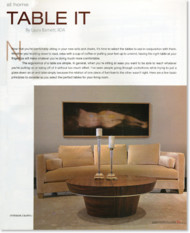
CLICK TO SEE IMAGE
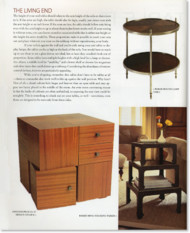
CLICK TO SEE IMAGE
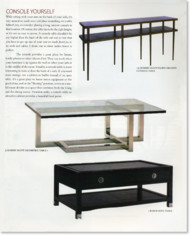
CLICK TO SEE IMAGE

CLICK TO SEE IMAGE
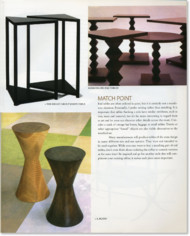
CLICK TO SEE IMAGE
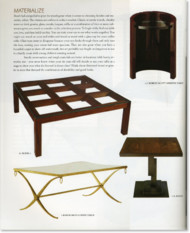
CLICK TO SEE IMAGE
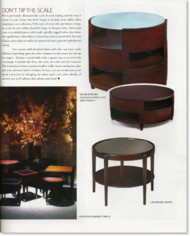
CLICK TO SEE IMAGE
Now that you're comfortably sitting in your new sofa and chairs, it's time to select the tables to use in conjunction with them. Whether you're sitting down to read, relax with a cup of coffee, or putting your feet up to unwind, having the right table at your fingertips will make whatever you're doing much more comfortable.
The ergonomics of a table are simple. In general, when you are sitting at ease you want to be able to reach whatever you're putting on it or taking off of it without too much effort. I've seen people going through contortions while trying to put a glass down on an end table simply because the relation of one piece of furniture to the other just wasn't right. Let's consider a few basic principles.
THE LIVING END
The height of your end tables should relate to the arm height of the sofa or chairs next to it. If the arms are high, the table should also be high-usually just about even with the arm height or an inch lower. If the arms are low, the table should follow suit-being even with the arm height or up to about three inches lower works well. If your seating is without arms, you can choose an end or occasional table that is either seat height or the height the arms would be. These proportions make it possible to reach your arm out and place whatever you want on the table top without repositioning your body.
If your sofa is against the wall and you're only using your end tables to display lamps, the tables can be as high as the back of the sofa. You would have to reach up to use them to set a glass down, not ideal, but at least they wouldn't look out of proportion. Some tables have multiple heights with a high level for a lamp or decorative object, a middle level for "usability", and a lower shelf or drawer for magazines and other items that could clutter up a tabletop. Considering the abundance of remote control devices, drawers are particularly appealing.
While you are shopping, remember that tables don't have to be tables at all—chests or commodes also work well in this up against the wall position. Why here? First of all, a closed cabinet feels larger and heavier than an open table and may appear too heavy placed in the middle of the room. An even more convincing reason is that the backs of cabinets are often unfinished, so exposing the rear view could be unsightly. This is something to check out on your tables, as well-sometimes, even those are designed to be seen only from three sides.
CONSOLE YOURSELF
While sitting with your arm on the back of your sofa, it's very natural to reach over and place something on a table behind you, so consider placing a long, narrow console in that location. Of course, the table has to be the right height, or it's not so easy to access. A console table shouldn't be any higher than the back of the sofa and not so low that you have to get up out of your seat to reach down to it. As with end tables, I think one to three inches lower is perfect. The console provides a great place for lamps, family photos, or other objects d'art. They can work when your furniture is up against the wall or when your sofa is in the middle of the room. Usually, a console table is more interesting to look at than the back of a sofa. If you need more storage, use a cabinet or buffet instead of an open table. It's a great place to house stereo equipment or the good china, and in the "floating" position, serves as a useful room divider in a space that combines both the living and the dining rooms. Function aside, a console table or attractive cabinet provides a beautiful focal point.
COFFEE, TEA, OR COCKTAIL?
No matter which beverage you are serving, I'm referring to the table that sits in front of your sofa. The coffee or cocktail varieties are really the same thing: usually large tables or groups of smaller ones; approximately the height of the seat of the sofa. Tea tables are different, about the size of a formal tea service and tray, taller overall—but still lower than a dining table. They were devised and named for the English custom of serving high-tea from the sofa in the parlor.
The overall shape and size of these tables varies with the floor plan and the length of the sofa. Sometimes it's just as long, but more often when the table is centered on the sofa; it is at least a foot shorter on either side. An average seven foot sofa usually has a table four or five feet long in front of it.
As with end or console tables, keep the coffee table close enough to reach it easily. Somewhere between twelve and eighteen inches away from the front of the sofa is standard. Twelve inches is easier to reach, but eighteen will make it easier to move around. The way you use your room and the proximity of the other tables will be the ultimate decision makers.
I'm sure you've seen large ottomans used in front of sofas in lieu of tables. These make it comfy to put your feet up and relax, but unless you have a very firm cushion or a very stable tray to put on the cushion, it sometimes places your drink in a precarious situation. I have noticed the trend moving away from this alternative simply because the details haven't been fully developed, but it can work.
MATCH POINT
End tables are often ordered in pairs, but it is certainly not a mandatory decision. Personally, I prefer mixing rather than matching. It is important that tables flanking a sofa have similar attributes, such as size, mass, and material, but it's far more interesting to regard them as art and let your eye discover other details across the room. Consider a stack of vintage hat boxes, luggage, or small tables. Trunks or other appropriate "found" objects are also viable alternatives to the matched set.
Many manufacturers will produce tables of the same design in many different size and use options. They were not intended to be used together. While you may want to buy a matching pair of end tables, don't even think about ordering the coffee or console versions at the same time! Be inspired and go for another style that will compliment, it makes each piece more important.
MATERIALIZE
Don't feel compelled to play the match game when it comes to choosing finishes and materials, either. The choices are endless in today's market. Classic or exotic woods, chunky stone or sleek granite, glass, metals, lacquer, raffia, or a combination of two or more substances, give you much to consider in the selection process. To begin with, find one table you love, and then build on that. You can train your eye to see what works together. You might use wood on your end tables and wood or metal with a glass top for your coffee table. Glass tops seem to disappear because your eye looks through them and only sees the base, making your room feel more spacious. They are also great when you have a beautiful carpet to show off underneath, but are probably too fragile or dangerous to use in a family room with young children running around.
Sturdy construction and tough materials are better in locations with heavy, everyday use—you never know when your six-year old will decide to use your table as a stage to show you what she learned in dance class! Think about distressed wood or granite in areas that demand the combination of durability and good looks.
DON'T TIP THE SCALE
We've previously discussed the scale of your seating and the way it relates to your room, but don't forget to include your tables when weighing in on a selection. If the scale of your sofa and chairs is large, the scale of your tables should be large to balance them. Don't pair your over-stuffed pieces with small, spindly-legged tables, but maintain equilibrium with tables or chests that carry as much heft. Save the thinner, more delicate tables for areas with more graceful upholstered seating.
Two rooms with identical chairs and sofas can look vastly different depending upon the other elements in the room. So, mix up the shapes—balance a round table with a square one, or an oval with a rectangle. Consider the lines, the scale, the color, and the material. This is the place where your personality really starts coming into play and your personal style is evident. In fact, you can re-decorate your whole room just by changing the tables (and a few other details, of course), but we'll shed a bit more "light" on that subject next time....
Click below to download PDF of entire article.
